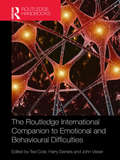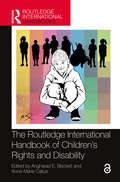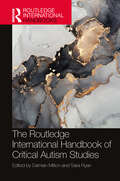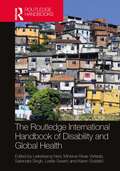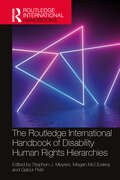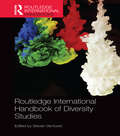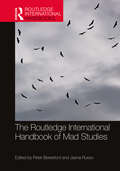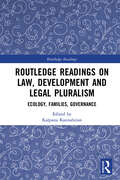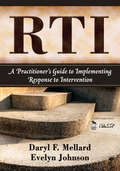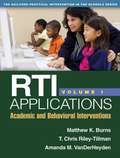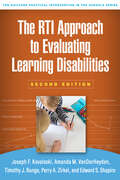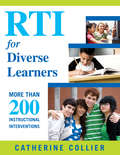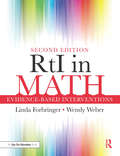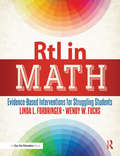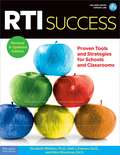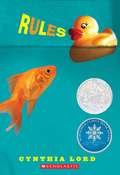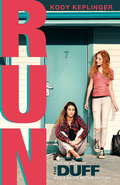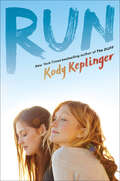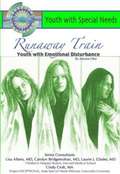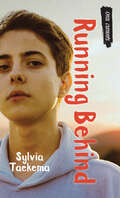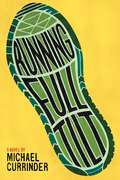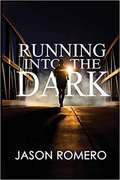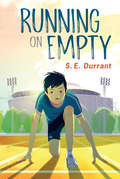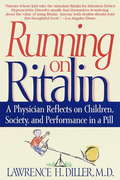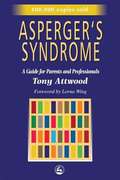- Table View
- List View
The Routledge International Companion to Emotional and Behavioural Difficulties
by Harry Daniels Ted Cole John VisserResponding to disruptive or troubled pupils with emotional and behavioural difficulties (EBD) remains a highly topical issue. The challenges these children present relate to wider issues of continuing political concern: the perceived declining discipline in schools; school and social exclusion; the limits to inclusion for children with special needs; increasing mental health difficulties in children; youth crime and parenting skills. It’s little wonder that the 'EBD' (often known as ‘BESD’ or ‘SEBD’) category is one of the most common forms of SEN around the world. This topical and exhaustively-researched Companion examines the difficulties of defining EBD, and the dangers of allocating this imprecise label to children. Bringing together the work of contributors from fifteen countries and across four continents, this book features the research of leading experts in the global field of EBD, who discuss and debate educators’ key concerns by: looking at the overlaps between EBD, ADHD and mental health difficulties; outlining the types of appropriate schooling for children with EBD; urging readers to look beyond pupils’ challenging behaviour in order to understand and respond to the social, biological and psychological causation; considering the key areas of assessment, whole-school and targeted approaches that help pupils with EBD in mainstream and in special settings; outlining helpful work with families, the crucial contribution of effective multi-agency working and the importance of supporting and developing teachers who work with challenging pupils. Containing contrasting views on controversial topics, this Companion’s approachable style makes it an essential reference book for academics, policy makers, practitioners, educators and students who are working towards a higher degree in education.
The Routledge International Handbook of Children's Rights and Disability (Routledge International Handbooks)
by Angharad E. Beckett Anne-Marie CallusThis handbook provides authoritative and cutting-edge analyses of various aspects of the rights and lives of disabled children around the world. Taking the UN Convention on the Rights of Persons with Disabilities (CRPD) and the UN Convention of the Rights of the Child (CRC) as conceptual frameworks, this work appraises the current state of affairs concerning the rights of disabled children across different stages of childhood, different life domains, and different socio-cultural contexts. The book is divided into four sections: Legislation and Policy Children’s Voice The Life Course in Childhood Life Domains in Childhood Comprised of 37 newly commissioned chapters featuring analyses of UN documents and case studies from Australia, Brazil, Ethiopia, Hong Kong, Italy, the Netherlands, Norway, Papua New Guinea, Serbia, South Africa, Spain, Sweden, the United Kingdom, the United States, and Vanuatu, its multidisciplinary approach reflects the complexities of the lives of disabled children and the multifarious nature of the strategies needed to ensure their rights are upheld. It will be of interest to researchers and students working in disability studies, education, allied health, law, philosophy, play studies, social policy, and the sociology of childhood. It will also be a valuable resource for professionals/practitioners, allowing them to consider future directions for ensuring that disabled children’s rights are realised and their well-being and dignity are assured.
The Routledge International Handbook of Critical Autism Studies (Routledge International Handbooks)
by Damian Milton and Sara RyanThis handbook provides an authoritative and up-to-date overview of Critical Autism Studies and explores the different kinds of knowledges and their articulations, similarities, and differences across cultural contexts and key tensions within this subdiscipline. Critical Autism Studies is a developing area occupying an exciting space of development within learning and teaching in higher education. It has a strong trajectory within the autistic academic and advocate community in resistance and response to the persistence of autism retaining an identity as a genetic disorder of the brain. Divided into four parts • Conceptualising autism • Autistic identity • Community and culture • Practice and comprising 24 newly commissioned chapters written by academics and activists, it explores areas of education, Critical Race Theory, domestic violence and abuse, sexuality, biopolitics, health, and social care practices. It will be of interest to all scholars and students of disability studies, sociology, anthropology, cultural studies, education, health, social care, and political science.
The Routledge International Handbook of Disability and Global Health (Routledge International Handbooks)
by Leslie Swartz Karen Soldatić Lieketseng Ned Minerva Rivas Velarde Satendra SinghThis handbook will raise awareness about the importance of health and well-being of people with disabilities in the context of the global development agenda: Leaving No-one Behind.There has been a growing discussion on how people with disabilities should be included in the global health landscape. An estimated one billion people have some form of disability, 80% of whom live in low- and middle-income settings. People with disabilities are more likely to be poor, with restricted access to health and social services, education, rehabilitation and employment. Despite this, people with disabilities are often overlooked in global health and development efforts. Furthermore, the COVID-19 pandemic has shown that unless systematically planned for and included in policies and programmes, people with disabilities remain at an increased risk of being adversely affected in times of humanitarian crisis and emergency disasters.Divided into eight sections: Disability and Health Frameworks Health Justice, Rights and Bioethics Gendering Disability Health Disability and Global Mental Health Disability and Access to Healthcare, Including Workforce Development Crises and Health Technology and Digital Health Disability, Ageing and Dementia Care This handbook covers the full range of topics pertaining to disability and global health including inclusive health; access to rehabilitation; global mental health and disability; medical training and disability; community based inclusive development for improving health and rehabilitation; maternal health and sexual reproduction; preventive care and health promotion for people with disabilities; health, disability and indigenous knowledges; bioethics and human rights; data protection; and health in the global south.It will be of interest to all scholars, students and professionals working in the fields of disability studies, health studies, nursing, medicine, allied health, development studies and sociology.
The Routledge International Handbook of Disability Human Rights Hierarchies (Routledge International Handbooks)
by Stephen J. Meyers Megan McCloskey Gabor PetriDisability is defined by hierarchy. Regardless of culture or context, persons with disabilities are almost always pushed to the bottom of the social hierarchy. With the advent of the Convention on the Rights of Persons with Disabilities (2006), disability human rights seemingly provided a path forward for tearing down ableist social hierarchies and ensuring that all persons with disabilities everywhere were treated equally. Despite important progress, the disability human rights project not only remains incomplete, but has often created new hierarchies among persons with disabilities themselves or across the human rights it promotes. Certain groups of persons with disabilities have gained new voices while others remain silenced and certain rights are prioritized over others depending on what states, international organizations, or advocates want rather than what those on the ground need most. This volume was inspired both by the continued need to expose human rights violations against persons with disabilities, but to also explore the nuanced role that hierarchies play in the spread, implementation, and protection of disability human rights. The enjoyment of human rights is not equal nor is the recognition of specific individuals and groups’ rights. In order to change this situation, inequalities across the disability human rights movement must be explored. Divided into five parts: Who counts as disabled? Political, social, and cultural context Which rights on top, whose rights on bottom? Pushed to the periphery in the disability rights movement Representations of disability and comprised of 34 newly-written chapters including case-studies from the Anglophone Caribbean, Bangladesh, Bosnia-Herzegovina, China, Ghana, Haiti, Hungary, India, Israel, Kenya, Latin America, Poland, Russia, Scotland, Serbia and South Africa, and other countries, this book will be of interest to all scholars and students of disability studies, sociology, human rights law and social policy.
Routledge International Handbook of Diversity Studies (Routledge International Handbooks)
by Steven VertovecIn recent years the concept of ‘diversity’ has gained a leading place in academic thought, business practice and public policy worldwide. Although variously used, ‘diversity’ tends to refer to patterns of social difference in terms of certain key categories. Today the foremost categories shaping discourses and policies of diversity include race, ethnicity, religion, gender, disability, sexuality and age; further important notions include class, language, locality, lifestyle and legal status. The Routledge Handbook of Diversity Studies will examine a range of such concepts along with historical and contemporary cases concerning social and political dynamics surrounding them. With contributions by experts spanning Sociology, Anthropology, Political Science, History and Geography, the Handbook will be a key resource for students, social scientists and professionals. It will represent a landmark volume within a field that has become, and will continue to be, one of the most significant global topics of concern throughout the twenty-first century.
The Routledge International Handbook of Mad Studies (Routledge International Handbooks)
by Peter BeresfordBy drawing broadly on international thinking and experience, this book offers a critical exploration of Mad Studies and advances its theory and practice. Comprised of 34 chapters written by international leading experts, activists and academics, this handbook introduces and advances Mad Studies, as well as exploring resistance and criticism, and clarifying its history, ideas, what it is, and what it can offer. It presents examples of mad studies in action, covering initiatives that have been taken, their achievements and what can be learned from them. In addition to sharing research findings and evidence, the book offers examples and insights for advancing understandings of experiences of madness and distress from the perspectives of those who have (had) those experiences, and also explores ways of supporting people oppressed by conventional understandings and systems. This book will be of interest to all scholars and students of Mad Studies, disability studies, sociology, socio- legal studies, mental health and medicine more generally.
Routledge Readings on Law, Development and Legal Pluralism: Ecology, Families, Governance (Routledge Readings)
by Kalpana KannabiranRoutledge Readings on Law, Development and Legal Pluralism presents some of the finest essays on social justice, environment, rights and governance. With a lucid new Introduction, it covers a vast range of issues and offers a compelling guide to understanding the harm and risk relating to biodiversity, agro-ecology, disaster, and forest rights. The book covers critical themes such as ecology, families and governance and establishes the trajectory of contemporary ecology and law in South Asia. The thirteen chapters in the volume, divided into three sections, trace violence and marginality in the plurality of families and their laws in India, as well as discuss community-based just practices. With debates on development, governance and families, the book highlights the politics and practices of law making, law reform and law application. This multi-disciplinary volume foregrounds the politics and plural lives of/in law by including perspectives from major authors who have contributed to the academic and/or policy discourse of the subject. This book will be useful to students, scholars, policymakers, practitioners and the general reader interested in a nuanced understanding of law, especially those studying law, marginality, kinship and indigeneity studies. It will serve as essential reading for those in law, socio-legal studies, environment studies and ecology, social exclusion studies, development studies, South Asian studies, human rights, jurisprudence and constitutional studies, gender studies, history, politics, conflict and peace studies, sociology and social anthropology. It will also appeal to legal historians and practitioners of law, environmentalists, and those in public administration.
RTI: A Practitioner's Guide to Implementing Response to Intervention
by Dr Daryl F. Mellard Evelyn S. JohnsonThis comprehensive yet accessible reference covers the three tiers of RTI, schoolwide screening, progress monitoring, challenges to implementation, and changes in school structures and individual staff roles.
RTI Applications, Volume 1: Academic and Behavioral Interventions (The Guilford Practical Intervention in the Schools Series #1)
by Matthew K. Burns T. Chris Riley-Tillman Amanda M. VanDerHeydenThis book addresses a crucial aspect of sustaining a response-to-intervention (RTI) framework in a school: selecting interventions with the greatest likelihood of success and implementing them with integrity. Leading RTI experts explain how to match interventions to students' proficiency levels, drawing on cutting-edge research about the stages of learning. Effective academic and behavioral interventions for all three tiers of RTI are described in step-by-step detail and illustrated with vivid case examples. In a large-size format with lay-flat binding for easy photocopying, the book features more than 40 reproducible planning tools and other helpful forms. Purchasers also get access to a Web page where they can download and print the reproducible materials.
The RTI Approach to Evaluating Learning Disabilities (The Guilford Practical Intervention in the Schools Series)
by Joseph F. Kovaleski Amanda M. VanDerHeyden Timothy J. Runge Perry A. Zirkel Edward S. ShapiroFrom leading authorities, this indispensable work is now in a revised and expanded second edition, presenting state-of-the-art tools and procedures for practitioners. The book shows how to use response to intervention (RTI) to evaluate K–12 students for specific learning disabilities (SLD). The second edition gives increased attention to optimizing the instructional environment in the context of a multi-tiered system of supports (MTSS). Procedures are described for screening at-risk students; using RTI to intensify instruction in reading, writing, and math; identifying SLD; determining eligibility for special education; and planning individualized education programs. Case examples and pointers for practice are woven throughout. In a convenient large-size format, the book includes reproducible tools that can be downloaded and printed for repeated use. New to This Edition *Incorporates contemporary perspectives on SLD, upgraded procedures for implementing an MTSS, new approaches to measuring RTI, and enhancements in using classroom observations. *Chapter on best practices in academic screening, including important dos and don'ts. *Separate chapters on using RTI for reading, written expression, and mathematics. *Chapter on RTI and special education law, focusing on what practitioners need to know. This book is in The Guilford Practical Intervention in the Schools Series, edited by Sandra M. Chafouleas.
RTI for Diverse Learners: More Than 200 Instructional Interventions
by Catherine C. CollierProvide targeted instruction to ELLs and other diverse learners! Many Response to Intervention (RTI) models were developed to identify specific learning disabilities in English-speaking students. This research-based resource provides more than 200 instructional interventions for using RTI with students from culturally and linguistically diverse backgrounds in Grades K–12, especially non-native English speakers and those with limited English proficiency. This book features: Interventions for students' cognitive, behavior, literacy, and communication issues at each tier of a multi-tier RTI framework A reader-friendly format and straightforward directions for using each intervention Examples from practice and a glossary to aid implementation
RtI in Math: Evidence-Based Interventions
by Linda Forbringer Wendy WeberLearn how to help K–8 students who struggle in math. Now in its second edition, this book provides a variety of clear, practical strategies that can be implemented right away to boost student achievement. Discover how to design lessons that work with struggling learners, implement math intervention recommendations from the Institute of Education Sciences Practice Guides, the National Center on Intensive Intervention, and CEC, use praise and self-motivation more effectively, develop number sense and computational fluency, teach whole numbers and fractions, increase students’ problem-solving abilities, and more! This edition features an all-new overview of effective instructional practices to support academic engagement and success, ideas for intensifying instruction within tiered interventions, and a detailed set of recommendations aligned to both CCSSM and CEC/CEEDAR’s High-Leverage Practices to help support students struggling to meet grade-level expectations. Extensive, current examples are provided for each strategy, as well as lesson plans, games, and resources.
RtI in Math: Evidence-Based Interventions for Struggling Students
by Wendy Fuchs Linda ForbringerLearn how to help K–8 students who struggle in math. This book provides a variety of clear, practical strategies that can be implemented right away to boost student achievement. You will find out how to design lessons that work with struggling learners, implement the recommendations for math intervention from the What Works Clearinghouse, use praise and self-motivation more effectively, develop number sense and computational fluency, teach whole numbers and fractions, increase students’ problem-solving abilities, and more! Extensive examples are provided for each strategy, as well as lesson plans, games, and resources.
RTI Success: Proven Tools And Strategies For Schools And Classrooms
by Elizabeth Whitten Kelli J. Esteves Alice WoodrowThis practical, ready-to-use resource gives teachers and administrators the tools to successfully implement RTI or strengthen an existing program to target students' specific needs. Response to Intervention allows educators to assess and meet the needs of struggling students before they have fallen too far behind. Three expert authors explore this multi-tiered system of support (MTSS), offering over one hundred research-based, instructional techniques and interventions for use in diverse settings, advice on creating personal and positive learning environments, information on co-teaching, and approaches to purposeful grouping. Included in the book and as digital downloads are easy-to-use customizable forms to streamline assessment, implementation, and documentation. Also included is an extensive list of references and resources for further exploration.
Rules
by Cynthia LordThis 2007 Newbery Honor Book is a humorous and heartwarming debut about feeling different and finding acceptance. Now in After Words paperback! Twelve-year-old Catherine just wants a normal life. Which is near impossible when you have a brother with autism and a family that revolves around his disability. She's spent years trying to teach David the rules from "a peach is not a funny-looking apple" to "keep your pants on in public"---in order to head off David's embarrassing behaviors. But the summer Catherine meets Jason, a surprising, new sort-of friend, and Kristi, the next-door friend she's always wished for, it's her own shocking behavior that turns everything upside down and forces her to ask: What is normal?
Run
by Kody KeplingerBo Dickinson is a girl with a wild reputation, a deadbeat dad, and an alcoholic mom. Everyone in town knows the Dickinsons are a bad lot, but Bo doesn't care what anyone thinks. Agnes Atwood has never stayed out past ten p.m., never gone on a date and never broken any of her parents' overbearing rules. Rules that are meant to protect their legally blind daughter - but Agnes isn't quite sure what they are protecting her from.Despite everything, Bo and Agnes become best friends. And it's the sort of friendship that runs truer and deeper than anything else. So when Bo shows up in the middle of the night, police sirens wailing in the distance, desperate to get out of town, Agnes doesn't hesitate to take off with her. But running away and not getting caught will require stealing a car, tracking down Bo's dad, staying ahead of the authorities, and - worst of all - confronting some ugly secrets.A story about the ferocity of friendship and the risks we'll take to save our friends ... And ourselves.
Run (Scholastic Press Novels)
by Kody KeplingerFrom the New York Times–bestselling author of The Duff. “A good unlikely friendship story . . . and a nuanced portrait of disability and small-town life.” —School Library JournalBo Dickinson is a girl with a wild reputation, a deadbeat dad, and a mama who’s not exactly sober most of the time. Everyone in town knows the Dickinsons are a bad lot, but Bo doesn’t care what anyone thinks.Agnes Atwood has never gone on a date, never even stayed out past ten, and never broken any of her parents’ overbearing rules. Rules that are meant to protect their legally blind daughter—protect her from what, Agnes isn’t quite sure.Despite everything, Bo and Agnes become best friends. And it’s the sort of friendship that runs truer and deeper than anything else. So when Bo shows up in the middle of the night, with police sirens wailing in the distance, desperate to get out of town, Agnes doesn’t hesitate to take off with her. But running away and not getting caught will require stealing a car, tracking down Bo’s dad, staying ahead of the authorities, and—worst of all—confronting some ugly secrets.“Bo and Agnes’ unlikely friendship rings true and strong . . . An ambitiously structured road-trip novel.” —Kirkus Reviews“There’s plenty to recommend . . . though the most effective thing here remains Agnes’ and Bo’s voices and the strength of their realistically tumultuous relationship.” ––Booklist
Runaway Train: Youth with Emotional Disturbance (Youth with Special Needs)
by Autumn LibalSheila leapt to her feet and tore her sheets from her bed. "Why can't anyone leave me alone?" she screamed. Her lamp crashed to the ground, shards of brown pottery smashing in every direction. She kicked the broken pieces, sending them spinning, then grabbed the nightstam heaved it onto the remains of the lamp. Her screams continued as she grabbed three jars of paint from her dresser. "I HATE YOU!" The jars exploded against the door like punctuation marks for her words. Black, red, and blue paint oozed down the wood, a grand finale to Sheila's performance. Panting, Sheila stared at the broken glass and pottery littering her bedroom floor. As the tears finally bubbled up, Sheila felt a strange sense of awe descending upon her. "What is wrong with me?" she whispered as she sank down on her bed. The tumultuous emotions of youth can be challenging to anyone, but for young people with emotional disturbance, the trials of growing up can be devastating. Young people with emotional disturbance can face many roadblocks in the quest to understand themselves and to gain understanding from others. In Runaway Train: Youth with Emotional Disturbance, you will learn about different causes of emotional disturbance, the special needs of youth who have them, and what can be done to help young people overcome emotional difficulties. Through the story of Sheila, you will learn what it is like to have an emotional disturbance, the dangers these conditions can pose, and the successes as well as the failures of systems currently available to assist youth with emotional disturbance.
Running Behind (Orca Currents)
by Sylvia TaekemaEven though he was once his biggest rival, Jake Jarvis is thrilled when Spencer Solomon agrees to join the Diamonds cross-country team to compete in the Barry's Bay provincial championships. Everyone is pumped, everyone is focused, and Jake has to admit, he really likes their chances. At the last moment, Spencer informs the team that he can't go. Jake is furious. But when Spencer explains that he's worried about leaving his wheelchair-bound father alone, Jake gets to work on finding a solution to get Spencer and the Diamonds back on track.
Running Full Tilt
by Michael CurrinderPraised by Jack Gantos, author of Dead End in Norvelt, as "a quick read with a kick at the finish," this debut novel sensitively and memorably captures a teen runner's relationship with his autistic older brother.Like most siblings, Leo and Caleb have a complicated relationship. But Caleb's violent outbursts literally send Leo running. When the family is forced to relocate due to Caleb's uncontrollable behavior, Leo tries to settle into a new school, joining the cross-country team and discovering his talent for racing and endurance for distance. Things even begin to look up for Leo when he befriends Curtis, a potential state champion who teaches Leo strategy and introduces him to would-be girlfriend, Mary. But Leo's stability is short-lived as Caleb escalates his attacks on his brother, resentful of his sport successes and new friendships.Leo can't keep running away from his problems. But, with a little help from Curtis and Mary, he can appreciate his worth as a brother and his own capacity for growth, both on and off the field.Praise from Jack Gantos, author of Dead End in Norvelt, Hole in My Life and The Trouble With Me: "Currinder's novel, Running Full Tilt, is a fast-paced convincing drama of a young runner whose legs circle him back to the many conflicts he is trying to escape--but he can't outrun himself. A quick read with a kick at the finish."Praise from Paul Volponi, author of The Final Four, Black and White, and Rikers High:"We feel the inner strength it takes to compete on every page of this splendid narrative, until, as readers, we are running as well--engrossed, and loving every step of the journey."
Running into the Dark: A Blind Man's Record-Setting Run Across America
by Jason RomeroA man takes on the challenge of a lifetime after hitting rock bottom. He finds himself divorced, unemployed and in a deep depression when a degenerative eye condition renders him blind with limited light perception. Feeling a calling to run across America, he dedicated the next two years of his life to prepare for, and ultimately run, over 3,000 miles from California to New York in less than 60 days, averaging 51.5 miles per day, to log the 7th fastest transcontinental foot crossing in the history of the world - less than 300 people have crossed America on foot. It was, and remains the only transcontinental foot-crossing by a blind person. <P><P> This is not just a book about running. This is a story of success and failure, healing and hurting, and loss and love. It is a book about struggling with adversity, learning to not give up or give in, to accept one's self for all that one is, and is not. It is every person's story. <P><P> Running into the Dark is a manifesto about how to continue ONWARD. <P><P> Jason Romero is a highly sought after Keynote Speaker for conventions, conferences and commencements, a US Paralympian who was 4th in the world at the Paralympic World Marathon Championships in 2015, a holder of 13 world records in ultra-running, the subject of a full length documentary and an author. In addition, Jason has been an attorney, an executive at GE and a CEO of a non-profit that helps children with Autism.
Running on Empty
by S. E. DurrantA boy shoulders great responsibility for his differently abled parents in this touching middle-grade story.CJ is a runner--and when he's running, he's fast, free, and flying. It was Grandad who taught him to run, and who did a lot more, besides. Grandad always made sure things were in order around CJ's house, because his parents could not. CJ's parents are different, and because they do not have the tools to cope with certain elements of everyday life, it was Grandad who reviewed the water bill, saw to it that the electricity meter had funds, and kept everything else shipshape. But now, with Grandad's sudden passing and Aunt Joan about to have a baby, CJ knows it's up to him to make sure Mum and Dad are okay and to keep the household going. It would be a hard job for any adult, but for a kid who's also starting middle-school and trying to impress the gruff track coach . . . is staying afloat even possible? Through its heartwarming and believable characters, Running on Empty sensitively explores the dynamics of a loving family finding its way forward, and the unexpected helping hands that pitch in along the way.
Running on Ritalin: A Physician Reflects on Children, Society, and Performance in a Pill
by Lawrence H. DillerIn a book as provocative and newsworthy asListening to ProzacandDriven to Distraction,a physician speaks out on America's epidemic level of diagnoses for attention deficit disorder, and on the drug that has become almost a symbol of our times: Ritalin. In 1997 alone, nearly five million people in the United States were prescribed Ritalin--most of them young children diagnosed with attention deficit disorder. Use of this drug, which is a stimulant related to amphetamine, has increased by 700 percent since 1990. And this phenomenon appears to be uniquely American: 90 percent of the world's Ritalin is used here. Is this a cause for alarm--or simply the case of an effective treatment meeting a newly discovered need? Important medical advance--or drug of abuse, as some critics claim? Lawrence Diller has written the definitive book about this crucial debate--evenhanded, wide-ranging, and intimate in its knowledge of families, schools, and the pressures of our speeded-up society. As a pediatrician and family therapist, he has evaluated hundreds of children, adolescents, and adults for ADD, and he offers crucial information and treatment options for anyone struggling with this problem. Running on Ritalinalso throws a spotlight on some of our most fundamental values and goals. What does Ritalin say about the old conundrums of nature vs. nurture, free will vs. responsibility? Is ADD a disability that entitles us to special treatment? If our best is not good enough, can we find motivation and success in a pill? Is there still a place for childhood in the performance-driven America of the late nineties? From the Hardcover edition.
Running with Walker: A Memoir
by Robert J. HughesWhen Walker Hughes is two years old, a neurologist tells his parents that he has autism and concludes, "I have very little hope for this child." Walker's parents refuse to accept this grim prognosis. With boundless energy and breathtaking creativity they set about to enhance his skills and enrich his life. There is no miracle cure, no magic key that unlocks the door to Walker's inner world. Hughes vividly describes his son's severe disability and at the same time portrays him as an exuberant, loving, and utterly unique individual.
